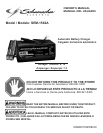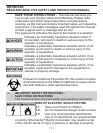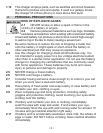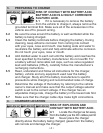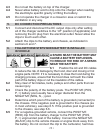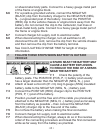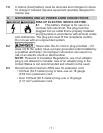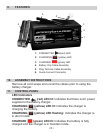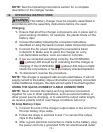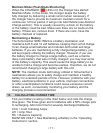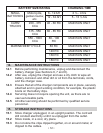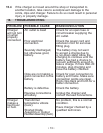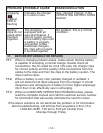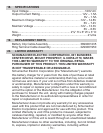
• 2 •
To reduce the risk of damage to the electric plug or cord, pull by 1.4
the plug rather than the cord when disconnecting the charger.
An extension cord should not be used unless absolutely necessary. 1.5
Use of an improper extension cord could result in a risk of re and
electric shock. If an extension cord must be used, make sure:
That the pins on the plug of the extension cord are the same •
number, size and shape as those of the plug on the charger.
That the extension cord is properly wired and in good •
electrical condition.
That the wire size is large enough for the AC ampere rating of •
the charger as specied in section 8.
To reduce the risk of electric shock, unplug the charger from the 1.6
outlet before attempting any maintenance or cleaning. Simply
turning off the controls will not reduce this risk.
Do not operate the charger with a damaged cord or plug; have 1.7
the cord or plug replaced immediately by a qualied service
person. (Call customer service at: 1-800-621-5485.)
Do not operate the charger if it has received a sharp blow, been 1.8
dropped or otherwise damaged in any way; take it to a qualied
service person. (Call customer service at: 1-800-621-5485.)
Do not disassemble the charger; take it to a qualied service 1.9
person when service or repair is required. Incorrect reassembly
may result in a risk of re or electric shock. (Call customer
service at: 1-800-621-5485.)
RISK OF EXPLOSIVE GASES.
WORKING IN THE VICINITY OF A LEAD-ACID 1.10
BATTERY IS DANGEROUS. BATTERIES GENERATE
EXPLOSIVE GASES DURING NORMAL BATTERY
OPERATION. FOR THIS REASON, IT IS OF UTMOST
IMPORTANCE THAT YOU FOLLOW THE INSTRUCTIONS
EACH TIME YOU USE THE CHARGER.
To reduce the risk of a battery explosion, follow these 1.11
instructions and those published by the battery manufacturer
and the manufacturer of any equipment you intend to use in the
vicinity of the battery. Review the cautionary markings on these
products and on the engine.



